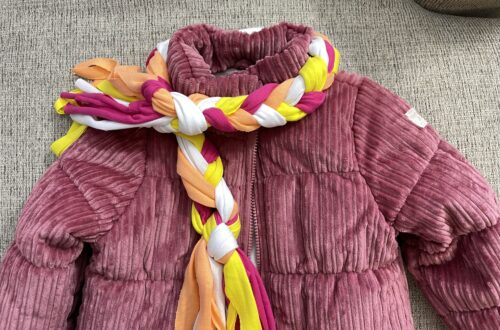5 Ways to Sew Patches Perfectly (QUOE TIPS)
 I have the habit of collecting a lot of craft supplies to use in later years once the pile grows out of control.
I have the habit of collecting a lot of craft supplies to use in later years once the pile grows out of control.
Some call it hoarding, I call it creative cataloging. One of the main things I am always picking up whenever possible is patches. There is just something about those little screen-printed or embroidered swatches of fabric that always draws me in. Over my time collecting patches, I’ve sewn more than my fair share, and have picked up the best ways to go about doing so for specific kinds. Now with the release of Clover’s Wonder Pins, the process is even easier!
Let’s get started with all you need to know for sewing patches.
Supplies:
- Gold Eye Applique Needles (Size 12)- Art. No 497/12
- Desk Needle Threader (Green) – Art. No 4072
- Thread Clipper “Kuroha”- Art. No 415
- Wonder Pins- Art. No 3210
- Universal Machine Needles – Art. No 9115
- Patches
- Fabric
- 50 Weight Thread
- Sewing Machine

Prep: Before sewing on the patches, cut the fabric down to its intended size. Tentatively place any patches onto fabric in desired sections. You may find that certain areas of the fabric are easier to work on with a sewing machine, like close to an edge. Once you have placed your patches in their intended positions, it would be a good idea to take a quick photo in case they are moved during pinning.


Pinning: Open your Wonder Pins and pin through patches into the fabric to secure. For larger patches, I recommend 4-6 pins, and for smaller patches 1-2 pins should work fine. Be sure to place pins at least 1/2 an inch away from the edge of your patches especially if you will be machine sewing them. By using locking Wonder Pins, the patch is completely secured with no pricked fingers, and the ability to completely hand or machine sew around the patch without having to remove pins as you go. Now we can begin sewing. There are five ways to sew a patch. The first two deal with machine sewing, and the last three deal with sewing by hand.



1. Machine Sewing Screen-Printed Patches:
For thinner styles of fabric patches, all that is required is a simple straight stitch. begin by prepping your sewing machine, and lowering the presser foot onto the raw edge of the patch. Typically with this style of patch, frayed edges are expected and wanted, so don’t worry about folding the raw edges over. Using the edge of the patch as a seam guide (about 1/4”), stitch along all sides of the patch, taking care to back stitch. For a more successful seam, make sure to have your stitch length on its lowest setting, and with no zigzag preset. Snip ends with thread clippers. Once you have finished any patch, you are safe to remove your Wonder Pins.




2. Machine Sewing Embroidered Patches:
For thicker, embroidered styles of patches we will be taking a different approach. Begin by setting your sewing machine to a zigzag stitch with the shortest stitch length possible. Place patch under presser foot with the edge directly in the midpoint. Sew around patch carefully, taking care to turn slowly. There is no need to back-stitch, however, you may find that you prefer the look of sewing around the patch twice to thicken the seam.




3. Hand Sewing Embroidered Patches:
In the case of hand sewing, use whatever size needle you are comfortable with. My go-to is always an applique needle in size 12. begin by threading your needle with the needle threader and around a size 50 thread. For smaller eyed needles such as the applique line, the threader is an absolute necessity. Double thread your needle to about 3 times the circumference of your patch. After securing the thread using your preferred method, use small whip-stitches to catch the edge of the patch around. I have found that the smaller and closer together the whip-stitches, the better. Finish with a quilter’s knot.




4. Hand Sewing Heat Set Patches:
Many patches nowadays have a heat-activated adhesive on their backside. If this is the case for any of yours, feel free to heat set the patch directly onto the fabric. Depending on the quality of the adhesive used, the patch may become loose over time. To prevent this, use a simple running stitch around the edge of the patch. This sewing is only preventative, so it does not have to be as tightly stitched or have as short stitch lengths as the others on this list. Think of this process as similar to basting paper piecing fabric.



5. Hand Sewing Screen-Printed Patches:
Lastly, we have arrived back to screen printed patches. All that is needed to adequately secure this patch by hand is a back-stitch. Again, stitch length is key to the longevity of your patch. Short tight stitches ensure that your patch won’t rip from your fabric, or have a frayed edge unravel. Back-stitch around the patch and finish with a quilter’s knot.



Now we have successfully mastered the art of sewing on a patch in any situation! Keep an eye out for my blogs over the upcoming months, you may find one that goes over how to create an embroidered patch along with a free pattern! The best thing is that you will know exactly how to attach it once it’s complete.

Catch up on the Series
- 5 Ways To Sew Patches Perfectly (This Post)
- English Paper Pieced Floret Patch
- Cross Stitch Patch
- Knit & Crochet Patches
- Sewing a Patched Project Bag
Follow what Quayln is up to next on his Blog | Instagram | Facebook | Pinterest | YouTube | Ravelry
Stay connected with Clover on Facebook | Twitter | Instagram | Pinterest | YouTube | Ravelry
[mc4wp_form id=”11289″]


